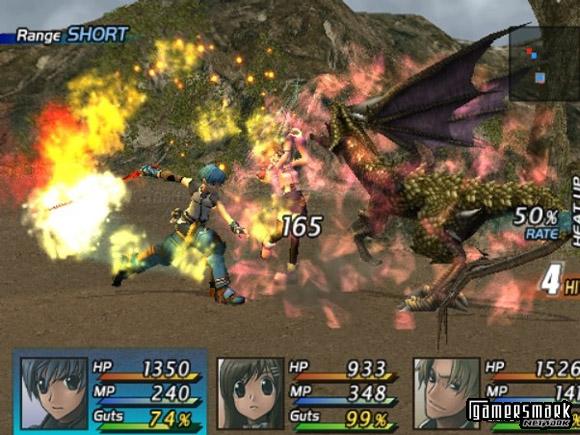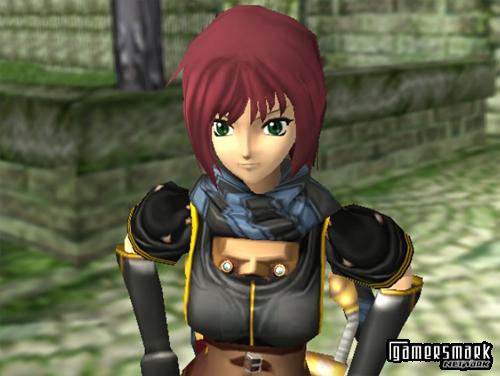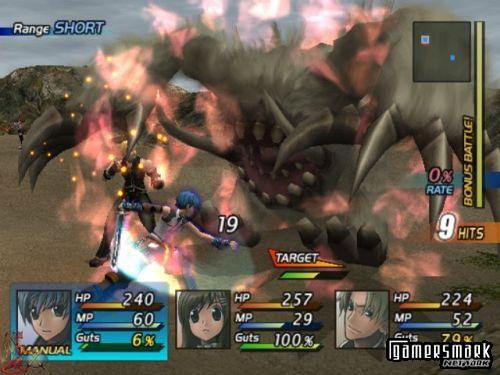Developer: Tri-Ace / Publisher: Square Enix || Overall: 8.8/10
As a trend, there only seems to be one Star Ocean game made every generation. The first Star Ocean was released on the Super Nintendo Entertainment System (SNES), and the second Star Ocean was released on the original PlayStation (PSOne). Through its unique battle system, interesting storyline, and immense item system, the Star Ocean series has gained quite a following. Originally an Enix-published game, the Star Ocean series’ third installment shows nothing but improvement after the merging of Squaresoft and Enix, largely due to the fact that Tri-Ace develops the game. The series has been revamped and improved to above and beyond what its predecessors had even dreamed to accomplish.
What really sets the Star Ocean games apart from all of its competitors are, instead of the turn-based system, real-time battles in a 3-D setting while mixing in traditional RPG elements. What also sets the Star Ocean series apart from others is that its storyline is science-fiction, one you rarely see in the RPG genre. No game in the Star Ocean series pulls off what Star Ocean is known for better than Star Ocean: Till the End of Time. Amazingly fun real-time battles, an overwhelming yet very fascinating story, and unique characters makes Star Ocean: Till the End of Time an amazing game and an unforgettable experience all at the same time.
Taking place in space itself, and on many different planets, Star Ocean: Till the End of Time creates a grandiose experience as you delve into the story visiting vastly different places that could only be experienced in a science fiction story. For at least half of the game, however, you will spend all of your time on one particular “primitive” planet that is in a state of war. Even though this major detour from the overall story may seem as something that the game could have done without, certain elements of the game are progressively introduced while on the planet, allowing the player to also get used to the battle system, learn a little bit more about the overall story and actually build an interest in whether or not the main characters of the story will make a difference in the escalating war. The “sub-story” on the planet ends up taking an important place in the overall story, so it doesn’t seem like it’s a total waste of time.
Included within the game is extra information that allows the player to further involve themselves in the universe of the Star Ocean: Till the End of Time, in a dictionary that adds words automatically whenever you run across information. The dictionary adds a lot of depth to the game and you begin to create an overall picture of the kind of universe Star Ocean: Till the End of Time is like. To fully understand the dictionary though, you may have to take a course in Physics, as many scientific terms are used, and even though they are explained in the game itself, you would still have a better understanding if you took a class. Something you can really appreciate with the game is that much of the information is actually believable as to how things work, and you can tell that the game developers did their homework when it came to the specifics of Astronomy and Physics in their dictionary terms, and in-game references to the topics. The extra effort of Tri-Ace adds to the believability and possibility for the events in the game as they unfold.
The actual story starts out when a teenage boy named Fayt is vacationing with his parents and a childhood friend named Sophia. While on the planet, the current state of the universe that is known about is explained, as well as just starting to learn how to use the battle system. You also learn of Fayt’s personal life a little bit and who he knows and holds dear to his heart, most namely his father, mother, and Sophia. This is all fine and dandy to begin with, because no conflict is actually introduced except for the fact that the Earth-founded Pangalactic Federation (which is more or less an alliance of many planets with many species) is in a seemingly everlasting war against another superpower named the Aldian Empire. When the planet Fayt is on is attacked by a third party, named the Vendeeni, this is where the true conflict in the game really begins. For a long time you will be kept in the dark about why the Vendeeni came to attack the planet Fayt was vacationing on, but when you’re finally told why they did it, the story begins to get even more interesting. As the story progresses, it gets better and better.
Star Ocean: Till the End of Time has a fun and involving real-time battle system, and this is where the game really shines. The real-time battle system is one of the most fun battle-systems ever created. Instead of a strict turn-based game, you take full control of your character, and, along with your other allies, beat the crap out of your enemies as fast and as hard as you can without taking too much of a toll on your characters.
Your character’s stats in battle rely on three different types of gauges: HP (Hit Points), MP (Mental Points), and Fury (a percentage that dictates how many moves you’re able to conduct before recharging. Some attacks take up more Fury than others). To succeed in the battles of the game, it would be wise to keep your HP and MP as high as you can, and conserve Fury enough so that you’re able to use your attacks effectively. Unlike most games, when your MP gauge is completely depleted, the character becomes knocked out. This adds to the strategy of your moves and being able to use the time you have to keep yourself and your allies from knocking out.
As your characters level up you can learn new abilities that will have to be used if you even want to have a chance at defeating some of the later enemies in the game, and learn how to use them effectively. When you use special abilities (depending on the kind of ability) it will take away HP, MP, or both. The amount use is usually not very significant, but when used without moderation, it can create difficulties for future battles. During battle, every attack used takes away a percentage from the Fury gauge, dictating how many times you’re able to conduct attacks in a string or other moves without recharging for a bit. The consideration of conserving Fury when you can during fast-paced battles becomes a part of the game’s challenge. Simply being able to mash the buttons on your controller won’t get you too far, as you will really have to know what you’re doing to progress in the game. The real-time battling also creates the challenge of keeping an eye on your allies, as well as trying to defeat the enemies you’re facing. How you actually play becomes paramount to winning battles, rather than just simply leveling up.
The faults of Star Ocean: Till the End of Time comes in how the story is formulated in certain aspects as well as how it’s delivered. Too often do you see unneeded parts of story that just seem like its fluff and not really even that interesting or important to the overall story. Most of the “fluff” stems off from playing as a character that comes off as fairly flat and not very well characterized. The “fluff” seems more like a failed attempt to truly characterize the main character. The same sort of feeling rubs off on some other characters, but the main character Fayt suffers the most from this sort of characterization flaw. There are other very unique characters in the game however, most notably being Cliff, Nel, Albel and even the little kid Roger (who seems to just be a comic relief character). There are other recurring characters that are not playable, and still take an important impact on the game’s storyline that are somewhat more interesting than Fayt. Adding to the “flatness” of Fayt’s character is really the voice acting for the character. It seemed to me, at least, that the voice actor had something to be desired in the acting, and really the dialogue in certain cases across different parts of the game needed some improvement. However, for the most part, the voice acting is a very good part about the game. At times, the music or sound effects in the background shrouds the dialogue being spoken, or take away from the concentration of listening to what characters are saying. On a side note, fans of the sci-fi RPG Xenosaga Episode I will also notice familiar voices in Star Ocean: Till the End of Time that were in Xenosaga Episode I. Quite a few of the voice actors who were in Xenosaga Episode I also worked as voice actors in Star Ocean: Till the End of Time. This may or may not be a good thing, but I don’t feel it matters to the overall quality of the game at all. Another fault of how the story was formulated is that through the first disc of the game there wasn’t enough space-oriented things, and you spent the vast majority of the time on a primitive planet fighting with swords and dealing with dragons and things that had to do with the planet you were on, and didn’t really have a whole lot to do with the main overall story other than the fact that Fayt is there and things happen there because he was.
On how the game actually looks and sounds like, Star Ocean: Till the End of Time is not the absolute best you’re going to find nowadays, but all the graphics are definitely smooth, and during the movies, very polished and very nice. There are a lot of space ship battle scenes that are shown throughout the game as well, and if you’re interested in the whole sci-fi scene you’ll appreciate the kinds of ships and action sequences concerning them. Music takes a weird place in the game, because even though a lot of music actually goes with the mood of the game, there are instances where there’s all of a sudden a rock song that doesn’t mix in with anything about the game. I have to say that this is the first RPG where I have seen flat out rock music with guitars and drums playing during the “exploring” parts of the game (though its not too bad in itself). It seems so out of place to me, considering that the battle music, background music during dialogue and all the other kinds of music used do not have the same kind of genre of music at all. It also depends on what planet you’re on, as the music arrangement changes for the most part, and there is different music being played during “exploring” parts later on in the game.
Another part about the game is the Invention System. This is more overly an optional part of the game you don’t have to participate in, but you are given the ability to create items to be sold in shops by patenting them. Items created by you or items created by other inventors will help you out on your quest by being able to buy better weapons and items that are better than the ones you usually used beforehand. Just the sheer amount of items that can be created is astounding, and actually fairly overwhelming. The part some people may like about it though is that because there are so many items to create, you’ll always be trying to create a new item that hasn’t been patented yet, if you so dared to actually care enough about it. Creating your own inventions is entirely optional, and you really don’t even have to make any inventions at all, but it is an extra part of the game that utilizes the massive amount of items that have always been included in the Star Ocean games.
Star Ocean: Till the End of Time displays a very good mix of all the elements an RPG should have, and taking a different approach at the whole genre by its use of real-time battles as its battle system. The amazingly fast-paced and challenging battles are something to be reveled, especially when it comes to how much the game has improved upon its predecessor. Star Ocean: Till the End of Time is definitely an excellent game to have, if you enjoy RPGs or enjoy Action games, as it is a unique experience all-around.



